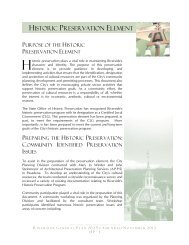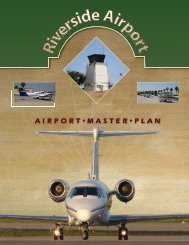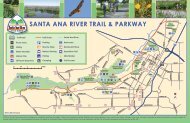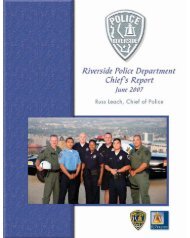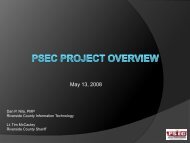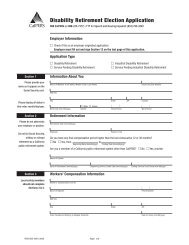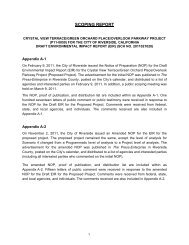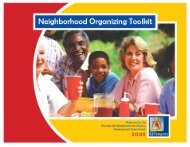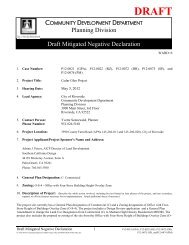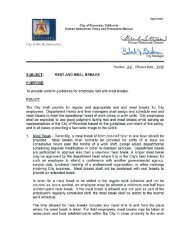Northside - City of Riverside
Northside - City of Riverside
Northside - City of Riverside
You also want an ePaper? Increase the reach of your titles
YUMPU automatically turns print PDFs into web optimized ePapers that Google loves.
COMMERCIAL/INDUSTRIAL DEVELOPMENT<br />
Though citrus continued to dominate the local economy until about 1930, the 1913<br />
freeze and the effects <strong>of</strong> World War I caused <strong>Riverside</strong>rs to reevaluate and diversify<br />
their commercial interests. Residential development occurred in a portion <strong>of</strong> the<br />
Main Street Industrial Corridor, but its conversion throughout the 20 th century to<br />
nearly exclusively commercial/industrial use was a sign <strong>of</strong> the decreased<br />
dependence on citrus and other agriculture and has prompted its identification as an<br />
industrial corridor unique from other areas <strong>of</strong> <strong>Riverside</strong>.<br />
Subdivided between 1906 and 1908 into four tracts south <strong>of</strong> the present SR-60 – E.N.<br />
Smith Subdivision (1906), North Main Street Tract (1907), File’s Subdivision No. 3<br />
(1907), and Wauregan’s Tract (1908) – the corridor quickly developed into three<br />
distinct areas and became connected to First Street with the extension <strong>of</strong> Main Street<br />
south. At one time, the Southern Pacific Company railroad line (1892) crossed over<br />
Main Street between First and Poplar Streets from the east/northeast where it<br />
entered the city along Massachusetts Avenue. At that point, it branched into two<br />
different directions – south to run parallel with the ATSF railroad along the citrus<br />
packinghouses on Pachappa Avenue, and west, along the railroad right-<strong>of</strong>-way in<br />
the Southeast Quadrant and across Main Street. At Main Street, the line split again,<br />
with two bridges over one area <strong>of</strong> Main Street, heading north and south. According<br />
to Sanborn Maps (1931), the concrete trestle over Main Street turned north as the<br />
<strong>Riverside</strong>, Rialto, and Pacific Railway, and the wooden trestle over Main Street<br />
turned south, curving onto Market Street, to be used by PE for the local electric<br />
streetcar line. North <strong>of</strong> First Street, Main Street still dips steeply at the former<br />
railroad right-<strong>of</strong>-way property, and access to shops from this area to Poplar Street is<br />
made most convenient for traveling consumers with asphalted, angled parking stalls<br />
that flow directly from the roadway. A WPA project in 1940 added concrete stops to<br />
this portion <strong>of</strong> Main Street.<br />
From the former Southern Pacific Company railroad right-<strong>of</strong>-way south to First<br />
Street, the land remained largely open. On the west side <strong>of</strong> Main Street, the PE<br />
housed a substation, and, later, Boyd & Lovesee Lumber Company occupied the<br />
area. A railroad freight house, bunkhouses, and the John Suverkrup Lumber<br />
Company were located on the east. New construction has eliminated this portion <strong>of</strong><br />
the corridor; in 1991-93, three buildings associated with the Salvation Army were<br />
constructed on the site <strong>of</strong> the Suverkrup lumberyard between Main and Orange<br />
Streets and in 2002, a low-income housing tract replaced the Boyd & Lovesee<br />
lumberyard and three historic single-family residences between Main and Market<br />
Streets.<br />
97



